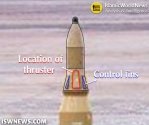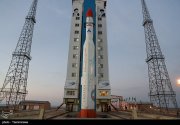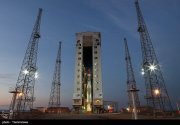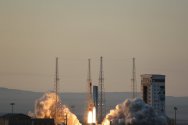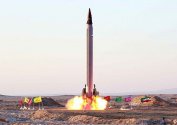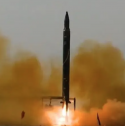IRANIAN PRESIDENT RAISI’S RENEWED EMPHASIS ON SPACE IS LIKELY TO CREATE NEW TENSIONS
Western press reporting on the first 100 days of Iran’s new hardline president, Ebrahim Raisi, has naturally focused on his impact on Iran’s nuclear and missile programs. But in Iran, officials refer to
three, not two, “” (eghtedar-saz) industries: nuclear, missiles, and space. And it is space, more so than either nuclear or missiles, where Raisi has focused his early public efforts.
In his first 100 days,
Raisi has moved to place his imprint by reinvigorating Iran’s space program, the results of which will be visible in the coming months and years. Raisi has now
set in motion a process that will result in Iran launching more satellites in the coming year, unveiling new space launch vehicles, and breaking ground on a new space launch facility in southern Iran. These developments will understandably be interpreted by Western media in the context of Iran’s missile programs and the broader security situation. But it is important to understand that
Iran is also deeply committed to the economic, military, and security uses of outer space.
Raisi Moves to Revive Iran’s Space Programs
Raisi is very publicly attempting to reinvigorate an Iranian space program that has been struggling in recent years. His new communications minister has criticized the state of the space program left by his predecessor — he called it “
” and “
” and
the head of the Iranian Space Agency. Raisi chaired a meeting of the
— the country’s highest-level space policymaking organization — which had not met for more than a decade. At that meeting,
Raisi committed Iran to launching more satellites into low earth orbit and reaching geostationary orbit by 2026.
The Revolutionary Guard’s space program exists outside this structure — and outside of Raisi’s control — just as the guard corps itself reports directly to Iran’s Supreme Leader through the Armed Forces General Staff, not to Iran’s president or defense minister. The Revolutionary Guard has organized and implemented its own parallel efforts to develop launchers, satellites, and ground facilities for military purposes.
The guard has described its space efforts as a “” (abar-perozheh) that integrates a complex of projects related to satellites, launchers, and satellite ground stations. To implement these efforts, the Revolutionary Guard manages its own parallel ecology of implementing organizations including research centers and a university.
Iran’s state space program under Raisi is organized around
two main goals: mastering the “” (charkheh-ye fanavari-e fazai) and sending “” (ensan be faza). The “space technology cycle” is by far the larger effort of the two. This encompasses
Iran’s development of satellites and the space launch vehicles to deliver them to various space orbits. The space technology cycle also involves constructing facilities across the country to launch and control satellites and receive and exploit their data. The language of a “cycle” seems to be borrowed from the nuclear field, where Iran’s goal is to master the full nuclear fuel cycle. The conception is consistent with a regime that emphasizes self-sufficiency (
khod-kafai) in the development of technology. The “
” effort is far smaller, but very real, and is
launch an Iranian astronaut to orbit onboard an Iranian launcher by 2032.
Iran’s goals under its state space program are longstanding and genuine.
Iranian leaders see space, along with nuclear and missile capabilities, as important “” (eghtedar-saz) industries for Iran’s economy, military, and security.
Iran’s official goal is to achieve “ in the region” in terms of space capabilities. Iranian officials frequently emphasize joining what they call the “
” of technologically advanced states. While Iran’s military is deeply involved in Iran’s space programs, it would be wrong to see the space program as a mere
for Iran’s significant and very public missile programs.
‘A Surprising Number of Launches’
Iran has real goals in space. These goals include
showing that Iran can, on a routine basis, place satellites in low earth orbit and operate them and placing Iran’s first satellite in a 36,000 kilometer for civilian and military uses of remote sensing, communications, and navigation services. Iran’s goals require it to develop families of satellites and space
of increasing capability — including a giant launcher to use cryogenic rocket engines — and constructing a major new launch site at
along the country’s southeast coast.
The steps taken in the first 100 days of the Raisi presidency suggest
we are likely to see Iranian attempts to make serious and rapid progress toward its space goals over the next year.
First,
Raisi has that Iranian satellite launches must become routine, what he calls “stabilizing” (
tasbit) Iran’s presence in low earth orbit. This means Iran will likely increase the launches of remote sensing and communications satellites using its Simorgh and Zoljanah space launch vehicles.
One outcome of the Supreme Space Council meeting was a detailed launch running through 1401 (the year ending in March 2023). Iran is currently building
satellites and has a
of older satellites awaiting launch. According to
, the key “choke point” (
galugah) has been “launching and launchers.” We also expect Iran to conduct test launches as part of launcher development and as incremental steps toward launching a satellite to geostationary orbit and launching an astronaut to low earth orbit.
If it can overcome the launch problems it has experienced in recent years, Iran could conduct a surprising number of launches in the coming year.
Beyond launches,
Iran will likely unveil new launch vehicles and satellites. Iran has already
small-scale models of
large liquid-fueled space launchers under development, like the Sarir and Soroush. Both the state and Revolutionary Guard space programs are developing solid-fueled space launchers as well.
New satellites are likely to include imaging satellites for civilian and military purposes, with down to one meter.
Iran will also likely announce the
construction of a new national launch site at Chabahar. Iran intends this site along the coast in southeastern Iran as the
for future space launches — of both satellites and astronauts — due to its position near the equator, its proximity to the Indian Ocean for safe launch corridors, and the region’s small population.
The Revolutionary Guard is unlikely to leave the spotlight solely to the state space program.
Iran’s draft national presented this month includes a line item for the guard’s Aerospace Force to accelerate (shetab-bakhshi) the development of its space industry. Though it is less transparent about the goals for its parallel space program,
we expect the Revolutionary Guard to continue its development of solid-propellant space launch vehicles.
Another
meeting of the Supreme Space Council is scheduled for March 2022 and another
satellite launch is scheduled for February 2022 (either Simorgh or Zoljanah).
After a 8 year hiatus, Iran's space program is back and re-invigorated.
By the end of 2023 hopefully Simorgh or Zoljanah will be operational - giving Iran the indigenous capability to reliably launch dozens of micro-sats (10-20kg), and smaller quantities of mini satellites (100-250kg), into LEO each year. This will enable Iran to work on heavier launchers such as the Sarir SLV, enabling insertion of medium satellites (500kg+) into higher orbits (GEO) by 2026.
Also worth remembering that the U.S. Astra rockets experienced 6 failures in a row before achieving a successful launch (with far greater budget - Simorgh only costs $3m per launch).
